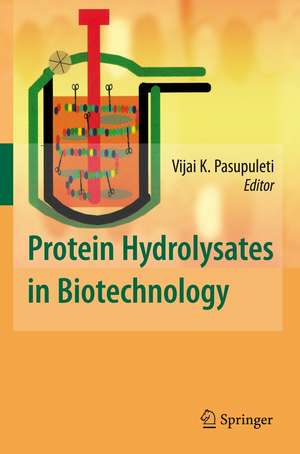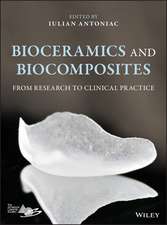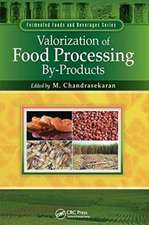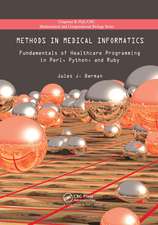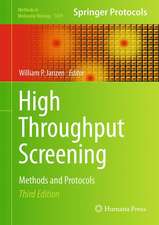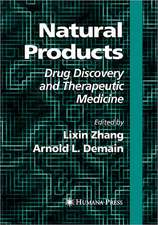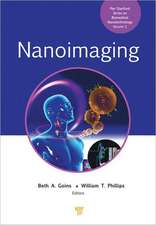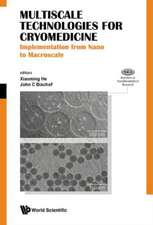Protein Hydrolysates in Biotechnology
Editat de Vijai K. Pasupuleti, Arnold L. Demainen Limba Engleză Paperback – 2 sep 2014
| Toate formatele și edițiile | Preț | Express |
|---|---|---|
| Paperback (1) | 637.78 lei 6-8 săpt. | |
| SPRINGER NETHERLANDS – 2 sep 2014 | 637.78 lei 6-8 săpt. | |
| Hardback (1) | 643.99 lei 6-8 săpt. | |
| SPRINGER NETHERLANDS – 14 sep 2010 | 643.99 lei 6-8 săpt. |
Preț: 637.78 lei
Preț vechi: 750.33 lei
-15% Nou
Puncte Express: 957
Preț estimativ în valută:
122.06€ • 126.96$ • 100.76£
122.06€ • 126.96$ • 100.76£
Carte tipărită la comandă
Livrare economică 15-29 aprilie
Preluare comenzi: 021 569.72.76
Specificații
ISBN-13: 9789401783200
ISBN-10: 9401783209
Pagini: 244
Ilustrații: XIII, 229 p.
Dimensiuni: 155 x 235 x 15 mm
Greutate: 0.35 kg
Ediția:2010
Editura: SPRINGER NETHERLANDS
Colecția Springer
Locul publicării:Dordrecht, Netherlands
ISBN-10: 9401783209
Pagini: 244
Ilustrații: XIII, 229 p.
Dimensiuni: 155 x 235 x 15 mm
Greutate: 0.35 kg
Ediția:2010
Editura: SPRINGER NETHERLANDS
Colecția Springer
Locul publicării:Dordrecht, Netherlands
Public țintă
ResearchCuprins
Applications of Protein Hydrolysates in Biotechnology.- State of the Art Manufacturing of Protein Hydrolysates.- Towards an Understanding of How Protein Hydrolysates Stimulate More Efficient Biosynthesis in Cultured Cells.- Benefits and Limitations of Protein Hydrolysates as Components of Serum-Free Media for Animal Cell Culture Applications.- Oligopeptides as External Molecular Signals Affecting Growth and Death in Animal Cell Cultures.- Use of Protein Hydrolysates in Industrial Starter Culture Fermentations.- Protein Hydrolysates from Non-bovine and Plant Sources Replaces Tryptone in Microbiological Media.- The Use of Protein Hydrolysates for Weed Control.- Physiological Importance and Mechanisms of Protein Hydrolysate Absorption.- Protein Hydrolysates/Peptides in Animal Nutrition.- Protein Hydrolysates as Hypoallergenic, Flavors and Palatants for Companion Animals.- The Development of Novel Recombinant Human Gelatins as Replacements for Animal-Derived Gelatin in Pharmaceutical Applications.
Textul de pe ultima copertă
The protein hydrolysates industry is growing rapidly yet there is no single book that describes the challenges and opportunities for manufacturers and end users, techniques used in manufacturing, characterization and screening of protein hydrolysates, their applications in a wide variety of industries in biotechnology. One of the misconceptions in using protein hydrolysates in fermentations is that the end user believes and uses it as a mere nitrogen source. However, the functionality of the product obtained is not necessarily due to protein hydrolysates alone because it may not be a pure peptide or a combination of peptides and may contain carbohydrates, lipids, micronutrients, etc., present in the raw material used or sometimes the manufacturers deliberately add to the process to bring unique functionality. Only a handful of manufacturers dictate this market that tend to keep manufacturing process proprietary making it harder to understand. This book will close the gap by unfolding information on latest developments.
Caracteristici
First book to describe the techniques used in manufacturing of protein hydrolysates and their application Information on latest developments by the protein hydrolysate manufacturers and its end users It is hoped that information described in this book will lead to further understanding of protein hydrolysated manufacturing and applications in general. Includes supplementary material: sn.pub/extras
